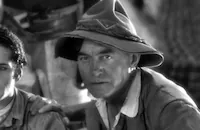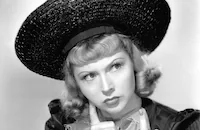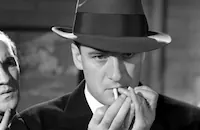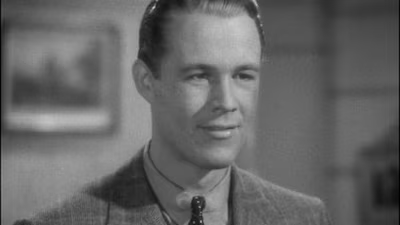Kid Galahad

Brief Synopsis
Cast & Crew
Michael Curtiz
Edward G. Robinson
Bette Davis
Humphrey Bogart
Wayne Morris
Jane Bryan
Film Details
Technical Specs

Synopsis
Bellhop Ward Guisenberry is mixing drinks at a party being thrown by boxing manager Nick Donati and his mistress, Louise Phillips, known as Fluff. When Sam McGraw, the fighter owned by gangster Turkey Morgan, insults Fluff, Ward punches him, knocking him out. To teach him a lesson, Turkey insists on a rematch between Ward and McGraw, and to avoid a conflict, Nick agrees. Ward goes along with the idea in order to earn enough money to buy a farm, although Fluff does her best to talk him out of fighting. To everyone's surprise, Ward wins the fight and has to leave town in a hurry to avoid Turkey's men. Fluff sends Ward to Nick's family's farm to hide out, despite Nick's rule that his family should never associate with anyone involved in boxing. Even Fluff has never met Nick's mother or sister Marie. Ward immediately charms Mrs. Donati and Marie, who hides her admiration by quarreling with him. When Nick learns where Ward is hiding, he quickly brings him back to the city where, now known as Kid Galahad, Ward goes on to great success as a boxer. Unaware that Fluff has fallen in love with him, Ward tells her of his love for Marie. Unselfishly, Fluff advises him to tell Marie, and realizing that she no longer loves Nick, leaves him to return to singing. Marie visits Ward in the city and they go to the nightclub where Fluff works. At the club, Ward gets into a fight with McGraw, and when reporters cover the story, Nick learns of Ward's relationship with Marie. In revenge, Nick agrees to let Ward fight the champion, even though he is not ready. He bets against Ward and suggests a strategy guaranteed to make Ward lose the fight. Fluff, however, realizes Nick's intentions and convinces him to change his plans. Ward wins the fight, and believing that he was double-crossed, Turkey shoots Nick and kills him.

Director

Michael Curtiz
Cast

Edward G. Robinson

Bette Davis

Humphrey Bogart

Wayne Morris

Jane Bryan

Harry Carey
William Haade

Soledad Jiminez
Joe Cunningham
Ben Welden

Joseph Crehan

Veda Ann Borg
Frank Faylen
Harlan Tucker
Bob Evans
Hank Hankinson
Bob Nestell
Jack Kranz

George Blake
George Humbert
Mary Doran
Billy Wayne
Virginia Dabney
Irene Coleman

Joyce Compton

Emmett Vogan
Curtis Benton
Eddy Chandler
Charles Randolph
Clayton Frye
Ben Hendricks
Huey White
Carlyle Moore

Jack Mower
John Sheehan
Kenneth Harlan
Philip Waldron

Ralph Dunn
Jack Hatfield
Horace Macmahon
Max Hoffman Jr.
Harry Harvey
Edward Price
Billy Arnold
Milt Kibbee
Don Brodie
Al Hill
Granville Owen
Eddie Fetherston
Andre Cheron

Elliott Sullivan
John Harron

John Ridgely
Donald Kerr
Mary Sunde
Don Downen
Everett Sullivan
Alexander Leftwich
Louis Natheaux
Jack Adair
Willard Hall
Crew
George Amy
Sam Bischoff
Leo F. Forbstein
Gaetano Gaudio
M. K. Jerome
Seton I. Miller
Orry-kelly
Irving Rapper
Jack Scholl
Jack Sullivan
Jack L. Warner
Carl Jules Weyl

Videos
Movie Clip



Trailer
Film Details
Technical Specs

Articles
Kid Galahad (1937)
Francis Wallace's novel, which had been serialized in The Saturday Evening Post, was a natural for Warner Bros. with its mix of boxing action and gangland corruption. The studio had the perfect actor for the role of tough fight manager Nick Donati in Edward G. Robinson, who had been a star there since his triumph in Little Caesar (1931). His gangland rival was a good role for supporting gangster star Humphrey Bogart. And the part of the young bellhop who belts his way to victory when the reigning champ puts the moves on Robinson's girlfriend (Davis), would be ideal for showcasing screen newcomer Wayne Morris.
Originally, studio head Jack Warner had considered casting newcomer Sarah Jane Fulks in the female lead, but with Davis now back at the studio and in a more pliable mood, he couldn't resist adding her star power to the film. Ms. Fulks would have to wait a few more years for stardom -- as Jane Wyman.
Davis was happy to accept the secondhand role, particularly as she was still waiting for the studio to develop a script for her next big vehicle, Jezebel (1938). She was also eager to work with Robinson, but after one day of shooting, he went to production chief Hal Wallis to demand she be replaced. In his opinion, she was little more than an uncontrolled, albeit gifted amateur. He would repeat that assessment in his memoirs, arguing that she had left the stage for Hollywood before developing control of her craft. Davis never spoke ill of Robinson, though she observed wryly in later years that he had stopped shooting during his death scene to complain to director Michael Curtiz that she and co-star Jane Bryan were drowning out his final speeches with their sobbing. The stars would never work together again.
One lasting relationship that came out of the film was between Davis and Irving Rapper, who would direct her biggest hit, Now, Voyager (1942). Rapper had just been hired as the film's dialogue director when, on his first day, he watched Curtiz staging a fight scene between Davis and Robinson. When Davis failed to respond properly to a shove from Robinson, Curtiz yelled, "That's not the way to fight, you goddamn bum!" Davis asked him to show her what he wanted, so Curtiz took her place in the scene. Robinson didn't want to throw the director around, afraid the larger man would hurt him, but he got into things when Curtiz started playing the scene as a Davis imitation. When Robinson pushed the director, he banged into a table and bounced back, almost knocking over his leading man. Davis got the point and stepped into the scene. But Robinson forgot to adjust the shove for his much lighter leading lady, and she went flying across the stage, landing in Rapper's lap. "My God, who are you?" she asked. When Rapper introduced himself as the film's new dialogue director, she quipped, "Thank God you caught the ball!" (Charles Higham, Bette: The Life of Bette Davis).
Kid Galahad ran into trouble with the industry's Production Code Administration both before and during production. While the script was being developed, PCA head Joseph Breen warned Warner's to make sure there was no clear indication that Davis was Robinson's mistress. There certainly are no lines to suggest they had a sexual relationship, though his easy presence in her apartment suggested more than the characters ever said. During filming, Breen became concerned that the relationship was too risqué and demanded reshoots, prompting Wallace to consider releasing the film without the Production Code's approval. Eventually they compromised by making a few more cuts. Nonetheless, Davis' character seemed to be punished for her "illicit" relationship with Robinson at the end when she walked off into the night alone (just as Davis had done, playing a far more questionable character in her previous film that year, Marked Woman).
The boxing scenes were as real and brutal as any filmed previously. After the scene in which Morris knocks out the champion in the ring, Curtiz screamed that it looked fake and demanded a re-take. But they had to wait for the actor to regain consciousness; he really was down for the count. When Kid Galahad came out, Wallace was so impressed he sent Morris a telegram, "Thank you for bringing our boy over the border of fiction into reality." (James Robert Parish, Hollywood Players: The Thirties).
Kid Galahad was a hit with critics and audiences alike, with many of them praising Robinson and Davis for their professionalism and singling out Morris as a bright new talent. Warner was so impressed he tried to buy the rights to Clifford Odets' play Golden Boy for the actor, but they went to Columbia, instead, where the 1939 film made William Holden a star. Ultimately, the studio would fail to come up with suitable follow-ups for the young actor, who would fade into supporting roles. The film became a minor triumph for Davis when, along with Marked Woman, it brought her Best Actress honors from the Venice Film Festival.
Many critics also hailed the film as the best boxing picture ever made, an honor later ceded to such hits as Golden Boy, Body and Soul (1947) and Raging Bull (1980). Warner's would recycle the story with a circus setting in 1941 as The Wagons Roll at Night, with Bogart stepping into Robinson's role, Sylvia Sidney in place of Davis and Eddie Albert as a rising lion tamer. When The Mirisch Bros. bought the story as a vehicle for Elvis Presley (with Gig Young and Lola Albright in the other leads), Warner's re-titled Kid Galahad for television prints as The Battling Bellhop to avoid confusion with the Elvis re-make.
Producer: Samuel Bischoff
Director: Michael Curtiz
Screenplay: Seton I. Miller
Based on the novel by Francis Wallace
Cinematography: Tony Gaudio
Art Direction: Carl Jules Weyl Music: Heinz Roemheld, Max Steiner
Principal Cast: Edward G. Robinson (Nick Donati), Bette Davis (Louise "Fluff" Phillips), Humphrey Bogart (Turkey Morgan), Wayne Morris (Kid Galahad/Ward Guisenberry), Jane Bryan (Marie Donati), Joseph Crehan (Editor Brady), Veda Ann Borg (Redhead at Party), Frank Faylen (Barney), Joyce Compton (Drunken Girl on Phone), Horace McMahon (Reporter), Mary Doran (Operator), Don DeFore (Reporter).
BW-102m. Closed captioning.
by Frank Miller

Kid Galahad (1937)
Quotes
Excuse me. Someone wanted me?- Ward Guisenberry
Mmm, I'll bet plenty of 'em do, honey.- The Redhead
It seems I'm always ringside at the first fight...and the last.- Louise 'Fluff' Phillips
Trivia
Notes
Kid Galahad was first published as a serial in The Saturday Evening Post (11 April-16 May 1936). The film's working title was The Battling Bellhop. In a Hollywood Reporter production chart, cameraman Arthur Edeson is erroneously listed as a film editor. Edeson May have worked on the film as a photographer, but the extent of his participation in the film has not been determined. Kid Galahad marked Wayne Morris' film debut. Joe Cunningham, who plays a reporter, was a newspaper reporter-turned-actor. The 1941 Warner Bros. film, The Wagons Roll at Night, starring Humphrey Bogart, was also based on the Wallace story and United Artists made a version entitled Kid Galahad in 1962, starring Elvis Presley. Modern sources credit Heinz Roemheld and Max Steiner with the score.

Miscellaneous Notes
Released in United States 1937
Released in United States 1937














